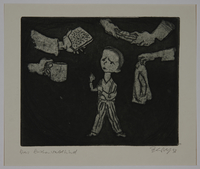Overview
- Brief Narrative
- Aquatint created by Herbert Sandberg of his youthful self and the delight and transcendance he found in nature. It is one in the series, Der Weg (The Path), a limited edition of 70 intaglio prints created from 1958-1965 for Buchenwald Museum for the 20th anniversary of liberation. Sandberg was imprisoned for 11 years by the Nazi regime, 7 under brutal conditions in Buchenwald concentration camp. Der Weg is a comprehensive autobiographical cycle, made to remind people of the day to day life destroyed by the Nazi dictatorship, as well as the horrors and immorality of the camps. The main sections are: prints 1-25, pre-1933 life; 26-60, resistance and persecution, including reconstructions of drawings Sandberg made while incarcerated; and 61-70, survivors postwar and the making of a new Germany. Sandberg, 26, was arrested in Berlin in 1934 for distributing anti-Nazi literature. He was convicted of treason and jailed. In 1938, he was transferred to the recently opened Buchenwald, as prisoner 3491, marked as both a Jewish and a political prisoner. In 1944, ill and in the infirmary, Sandberg created his first artworks as a prisoner. Buchenwald was liberated on June 12, 1945, by US troops. Sandberg returned to Berlin and resumed his career.
- Artwork Title
- Wandervogel
- Alternate Title
- Wayfarers
- Series Title
- Der Weg 70 Aquatinta-Radierungen
- Date
-
creation:
1962
depiction: approximately 1925
- Geography
-
creation:
Berlin (Germany : East)
- Credit Line
- United States Holocaust Memorial Museum Collection
- Markings
- front, on sheet below image, ink : Wondervögel [Wayfarers]
- Signature
- front, on sheet, below right corner of image, pencil : HSandberg 62
- Contributor
-
Artist:
Herbert Sandberg
Subject: Herbert Sandberg
- Biography
-
Herbert Sandberg was born on April 14, 1908, in Posen, Germany, (later Poznan, Poland) to an Orthodox Jewish couple, Eva and Salomon Sandberg. His father Salomon was a leather merchant. Shortly after his birth, the family move to Hindenberg, also in the Silesian/ Prussian region of Germany (later Zabrze, Poland). When Herbert was a teenager, they moved to Breslau, (later Wroclaw, Poland) where he attended high school. After graduation, he briefly attended trade school, and worked in a bank, but then pursued an art education, which led to a break with his father who did not approve. Between 1925 and 1928, Herbert attended a local Arts and Crafts School in Breslau, and studied with Otto Müller at Breslau's Academy of Fine Arts. He also began working as an illustrator and newspaper cartoonist. In 1927, Herbert began his association with Bertolt Brecht after he was hired by the Breslau Volksbühnenzeitschrift, a theatre magazine, to draw a portrait of Brecht in his Berlin studio. In 1928, Herbert's father immigrated to Palestine, where his wife and daughters joined him in 1930. In 1928, Herbert moved to Berlin where he worked for major newspapers, such as Berliner Tageblatt. He joined the Revolutionary German Artists' Association (ASSO). In 1930, he became a member of the Communist Party, for which he created and distributed leaflets, posters, and other graphic materials. In January 1933, Hitler was appointed chancellor of Germany. After the Reichstag Fire in February, civil rights were suspended. Germany became a police state and those who opposed the government were persecuted. In 1934, Sandberg was arrested for distributing anti-Nazi literature and imprisoned in Berlin-Plotzensee Prison. He was convicted of treason and sent to Brandenburg-Gorden Prison.
On July 21, 1938, Sandberg was transferred to Buchenwald concentration camp. He was prisoner number 3491 and identified as both a Jewish prisoner and a political prisoner. He was removed from a 1943 deportation transport to Auschwitz because of his training as a stone mason. Wilhelm Hammer, a teacher incarcerated at the camp, had persuaded the German SS authorities to allow him to establish a formal training program to teach prisoners stone masonry. The SS operated several business enterprises at the camp, including a stone quarry. Sandberg never admitted to being an artist, but he was registered as a skilled stone mason and was kept at Buchenwald to assist this program. In 1944, Sandberg fell ill and was hospitalized. While in the infirmary, he created his first artworks since his imprisonment. The cycle, called Eine Freundschaft [This Picture Diary], was smuggled out of the camp.
Buchenwald was liberated on June 12, 1945, by American forces. Sandberg returned to Berlin, which in 1949 became part of the newly established Deutsche Demokratische Republik (DDR), known as East Germany, Sandberg retrieved his prison artwork which was incorporated into a work published in 1949 in Berlin, East Germany. In 1959, Sandberg was commissioned by the Buchenwald Committee for the Buchenwald Museum to take the original fragile drawings from Buchenwald concentration camp as well as newly created works and create a limited edition aquatint etching folio. The series, Der Weg [The Path], was completed between 1958 and 1965, in an edition of 25-30, after which the plates were destroyed. An inexpensive book of the prints was published in 1966. Sandberg, 73, died on March 18, 1991, in Berlin.
Physical Details
- Language
- German
- Classification
-
Art
- Category
-
Prints
- Object Type
-
Aquatint--Autobiography (lcsh)
- Physical Description
- Aquatint etching on paper depicting a large bonfire with tall flames transforming into a man and woman dancing with joined hands. The woman, on the left, wears a long flowing cap with a curled top and the man wears a cap and striped shirt. Seated around the fire, leaning back in amazement are 4 young people, singing and playing guitars. In the background is a dark forest with rows of trees. Signed by the artist. This is five in a series of 70 prints, Der Weg.
- Dimensions
- overall: Height: 12.625 inches (32.068 cm) | Width: 15.750 inches (40.005 cm)
pictorial area: Height: 7.750 inches (19.685 cm) | Width: 9.625 inches (24.448 cm) - Materials
- overall : wove paper, ink
- Inscription
- front, bottom corners, ink : 40/50 / 5
Rights & Restrictions
- Conditions on Access
- No restrictions on access
- Conditions on Use
- Restrictions on use
Keywords & Subjects
- Topical Term
- Artists--Germany--Berlin--20th century--Biography. Autobiography in art. Caricatures and cartoons--Germany--Biography. Cartoonists--Germany--20th century--Biography. Holocaust, Jewish (1939-1945), in art. Political prisoners--Germany--Biography.
- Geographic Name
- Germany--Social conditions--20th century--Pictorial works.
- Personal Name
- Sandberg, Herbert, 1908-1991--Pictorial works.
Administrative Notes
- Legal Status
- Permanent Collection
- Provenance
- The aquatint was acquired by the United States Holocaust Memorial Museum in 1988.
- Funding Note
- The cataloging of this artifact has been supported by a grant from the Conference on Jewish Material Claims Against Germany.
- Record last modified:
- 2022-07-28 18:29:32
- This page:
- https://collections.ushmm.org/search/catalog/irn521130
Download & Licensing
In-Person Research
- By Appointment
- Request 21 Days in Advance of Visit
- Plan a Research Visit
- Request to See This Object
Contact Us
Also in Herbert Sandberg collection
The collection consists of seventy aquatints for the series Der Weg created by Herbert Sandberg on commission from 1958-1965 for the Buchenwald Museum in East Germany (now Germany) on the site of the concentration camp where he had been imprisoned during the Holocaust and incorporating work he had drawn while an inmate.
Date: 1958-1965

Plate 1, Herbert Sandberg, Der Weg: young painter being told to pursue money not art
Object
Aquatint created by Herbert Sandberg about his youthful decision to become an artist, not a banker, despite his father's disapproval. It is one in the series, Der Weg [The Way], a limited edition of 70 intaglio prints created from 1958-1965 for Buchenwald Museum for the 20th anniversary of liberation. Sandberg was imprisoned for 11 years by the Nazi regime, 7 under brutal conditions in Buchenwald concentration camp. Der Weg is a comprehensive autobiographical cycle, made to remind people of the day to day life destroyed by the Nazi dictatorship, as well as the horrors and immorality of the camps. The main sections are: prints 1-25, pre-1933 life; 26-60, resistance and persecution, including reconstructions of drawings Sandberg made while incarcerated; and 61-70, survivors postwar and the making of a new Germany. Sandberg, 26, was arrested in Berlin in 1934 for distributing anti-Nazi literature. He was convicted of treason and jailed. In 1938, he was transferred to the recently opened Buchenwald, as prisoner 3491, marked as both a Jewish and a political prisoner. In 1944, ill and in the infirmary, Sandberg created his first artworks as a prisoner. Buchenwald was liberated on June 12, 1945, by US troops. Sandberg returned to Berlin and resumed his career.

Plate 2, Herbert Sandberg, Der Weg: youth carryies books past men hunched over desks
Object
Aquatint created by Herbert Sandberg about his youthful decision to become an artist, not a banker, despite his father's disapproval. It is one in the series, Der Weg [The Path], a limited edition of 70 intaglio prints created from 1958-1965 for Buchenwald Museum for the 20th anniversary of liberation. Sandberg was imprisoned for 11 years by the Nazi regime, 7 under brutal conditions in Buchenwald concentration camp. Der Weg is a comprehensive autobiographical cycle, made to remind people of the day to day life destroyed by the Nazi dictatorship, as well as the horrors and immorality of the camps. The main sections are: prints 1-25, pre-1933 life; 26-60, resistance and persecution, including reconstructions of drawings Sandberg made while incarcerated; and 61-70, survivors postwar and the making of a new Germany. Sandberg, 26, was arrested in Berlin in 1934 for distributing anti-Nazi literature. He was convicted of treason and jailed. In 1938, he was transferred to the recently opened Buchenwald, as prisoner 3491, marked as both a Jewish and a political prisoner. In 1944, ill and in the infirmary, Sandberg created his first artworks as a prisoner. Buchenwald was liberated on June 12, 1945, by US troops. Sandberg returned to Berlin and resumed his career.
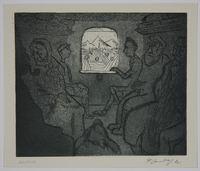
Plate 3, Herbert Sandberg, Der Weg: youth looking out window of a crowded train
Object
Aquatint created by Herbert Sandberg about his youthful decision to become an artist, not a banker, despite his father's disapproval. It is one in the series, Der Weg (The Path), a limited edition of 70 intaglio prints created from 1958-1965 for Buchenwald Museum for the 20th anniversary of liberation. Sandberg was imprisoned for 11 years by the Nazi regime, 7 under brutal conditions in Buchenwald concentration camp. Der Weg is a comprehensive autobiographical cycle, made to remind people of the day to day life destroyed by the Nazi dictatorship, as well as the horrors and immorality of the camps. The main sections are: prints 1-25, pre-1933 life; 26-60, resistance and persecution, including reconstructions of drawings Sandberg made while incarcerated; and 61-70, survivors postwar and the making of a new Germany. Sandberg, 26, was arrested in Berlin in 1934 for distributing anti-Nazi literature. He was convicted of treason and jailed. In 1938, he was transferred to the recently opened Buchenwald, as prisoner 3491, marked as both a Jewish and a political prisoner. In 1944, ill and in the infirmary, Sandberg created his first artworks as a prisoner. Buchenwald was liberated on June 12, 1945, by US troops. Sandberg returned to Berlin and resumed his career.
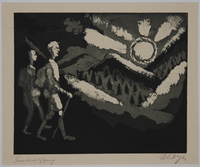
Plate 4, Herbert Sandberg, Der Weg: 2 young men hike toward a rising sun
Object
Aquatint created by Herbert Sandberg of his youthful self and the delight and transcendance he found in nature. It is one in the series, Der Weg (The Path), a limited edition of 70 intaglio prints created from 1958-1965 for Buchenwald Museum for the 20th anniversary of liberation. Sandberg was imprisoned for 11 years by the Nazi regime, 7 under brutal conditions in Buchenwald concentration camp. Der Weg is a comprehensive autobiographical cycle, made to remind people of the day to day life destroyed by the Nazi dictatorship, as well as the horrors and immorality of the camps. The main sections are: prints 1-25, pre-1933 life; 26-60, resistance and persecution, including reconstructions of drawings Sandberg made while incarcerated; and 61-70, survivors postwar and the making of a new Germany. Sandberg, 26, was arrested in Berlin in 1934 for distributing anti-Nazi literature. He was convicted of treason and jailed. In 1938, he was transferred to the recently opened Buchenwald, as prisoner 3491, marked as both a Jewish and a political prisoner. In 1944, ill and in the infirmary, Sandberg created his first artworks as a prisoner. Buchenwald was liberated on June 12, 1945, by US troops. Sandberg returned to Berlin and resumed his career.
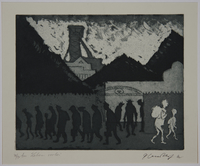
Plate 6, Herbert Sandberg, Der Weg: 2 people passing silhouetted workers leaving a factory
Object
Aquatint created by Herbert Sandberg about what his life might have been like if he had not become an artist, despite his father's disapproval. It is one in the series, Der Weg [The Path], a limited edition of 70 intaglio prints created from 1958-1965 for Buchenwald Museum for the 20th anniversary of liberation. Sandberg was imprisoned for 11 years by the Nazi regime, 7 under brutal conditions in Buchenwald concentration camp. Der Weg is a comprehensive autobiographical cycle, made to remind people of the day to day life destroyed by the Nazi dictatorship, as well as the horrors and immorality of the camps. The main sections are: prints 1-25, pre-1933 life; 26-60, resistance and persecution, including reconstructions of drawings Sandberg made while incarcerated; and 61-70, survivors postwar and the making of a new Germany. Sandberg, 26, was arrested in Berlin in 1934 for distributing anti-Nazi literature. He was convicted of treason and jailed. In 1938, he was transferred to the recently opened Buchenwald, as prisoner 3491, marked as both a Jewish and a political prisoner. In 1944, ill and in the infirmary, Sandberg created his first artworks as a prisoner. Buchenwald was liberated on June 12, 1945, by US troops. Sandberg returned to Berlin and resumed his career.
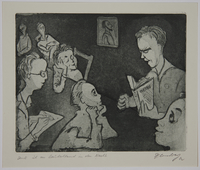
Plate 7, Herbert Sandberg, Der Weg: man reciting Heine to young boys
Object
Aquatint created by Herbert Sandberg of himself as a young boy, listening to a teacher recite Heine. It is one in the series, Der Weg (The Path), a limited edition of 70 intaglio prints created from 1958-1965 for Buchenwald Museum for the 20th anniversary of liberation. Sandberg was imprisoned for 11 years by the Nazi regime, 7 under brutal conditions in Buchenwald concentration camp. Der Weg is a comprehensive autobiographical cycle, made to remind people of the day to day life destroyed by the Nazi dictatorship, as well as the horrors and immorality of the camps. The main sections are: prints 1-25, pre-1933 life; 26-60, resistance and persecution, including reconstructions of drawings Sandberg made while incarcerated; and 61-70, survivors postwar and the making of a new Germany. Sandberg, 26, was arrested in Berlin in 1934 for distributing anti-Nazi literature. He was convicted of treason and jailed. In 1938, he was transferred to the recently opened Buchenwald, as prisoner 3491, marked as both a Jewish and a political prisoner. In 1944, ill and in the infirmary, Sandberg created his first artworks as a prisoner. Buchenwald was liberated on June 12, 1945, by US troops. Sandberg returned to Berlin and resumed his career.

Plate 8, Herbert Sandberg, Der Weg: youth looks with longing at a bookstore window
Object
Aquatint created by Herbert Sandberg of his younger self and his growing conviction that he must become an artist, despite his father's disapproval. It is one in the series, Der Weg (The Path), a limited edition of 70 intaglio prints created from 1958-1965 for Buchenwald Museum for the 20th anniversary of liberation. Sandberg was imprisoned for 11 years by the Nazi regime, 7 under brutal conditions in Buchenwald concentration camp. Der Weg is a comprehensive autobiographical cycle, made to remind people of the day to day life destroyed by the Nazi dictatorship, as well as the horrors and immorality of the camps. The main sections are: prints 1-25, pre-1933 life; 26-60, resistance and persecution, including reconstructions of drawings Sandberg made while incarcerated; and 61-70, survivors postwar and the making of a new Germany. Sandberg, 26, was arrested in Berlin in 1934 for distributing anti-Nazi literature. He was convicted of treason and jailed. In 1938, he was transferred to the recently opened Buchenwald, as prisoner 3491, marked as both a Jewish and a political prisoner. In 1944, ill and in the infirmary, Sandberg created his first artworks as a prisoner. Buchenwald was liberated on June 12, 1945, by US troops. Sandberg returned to Berlin and resumed his career.

Plate 9, Herbert Sandberg, Der Weg: boy discovers artistic inspiration
Object
Aquatint created by Herbert Sandberg of his younger self discovering "Die Freude Monatshefte fur deutsche Innerlichkeit [The Joy, Monthly Journal for German Inner Life], an avant garde journal. During this time, he was understanding that he must become an artist, despite his father's disapproval. It is one in the series, Der Weg (The Path), a limited edition of 70 intaglio prints created from 1958-1965 for Buchenwald Museum for the 20th anniversary of liberation. Sandberg was imprisoned for 11 years by the Nazi regime, 7 under brutal conditions in Buchenwald concentration camp. Der Weg is a comprehensive autobiographical cycle, made to remind people of the day to day life destroyed by the Nazi dictatorship, as well as the horrors and immorality of the camps. The main sections are: prints 1-25, pre-1933 life; 26-60, resistance and persecution, including reconstructions of drawings Sandberg made while incarcerated; and 61-70, survivors postwar and the making of a new Germany. Sandberg, 26, was arrested in Berlin in 1934 for distributing anti-Nazi literature. He was convicted of treason and jailed. In 1938, he was transferred to the recently opened Buchenwald, as prisoner 3491, marked as both a Jewish and a political prisoner. In 1944, ill and in the infirmary, Sandberg created his first artworks as a prisoner. Buchenwald was liberated on June 12, 1945, by US troops. Sandberg returned to Berlin and resumed his career.
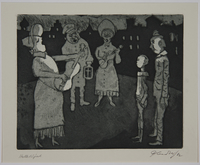
Plate 10, Herbert Sandberg, Der Weg: two youth listening to a trio of Christian street singers
Object
Aquatint created by Herbert Sandberg of his younger self and his growing conviction that he must become an artist, despite his father's disapproval. It is one in the series, Der Weg [The Path], a limited edition of 70 intaglio prints created from 1958-1965 for Buchenwald Museum for the 20th anniversary of liberation. Sandberg was imprisoned for 11 years by the Nazi regime, 7 under brutal conditions in Buchenwald concentration camp. Der Weg is a comprehensive autobiographical cycle, made to remind people of the day to day life destroyed by the Nazi dictatorship, as well as the horrors and immorality of the camps. The main sections are: prints 1-25, pre-1933 life; 26-60, resistance and persecution, including reconstructions of drawings Sandberg made while incarcerated; and 61-70, survivors postwar and the making of a new Germany. Sandberg, 26, was arrested in Berlin in 1934 for distributing anti-Nazi literature. He was convicted of treason and jailed. In 1938, he was transferred to the recently opened Buchenwald, as prisoner 3491, marked as both a Jewish and a political prisoner. In 1944, ill and in the infirmary, Sandberg created his first artworks as a prisoner. Buchenwald was liberated on June 12, 1945, by US troops. Sandberg returned to Berlin and resumed his career.

Plate 11, Herbert Sandberg, Der Weg: hand giving 500 million mark note to a beggar
Object
Aquatint by Herbert Sandberg about his experiences during the monetary crisis in 1920s Germany. It is one in the series, Der Weg [The Path], a limited edition of 70 intaglio prints created from 1958-1965 for Buchenwald Museum for the 20th anniversary of liberation. Sandberg was imprisoned for 11 years by the Nazi regime, 7 under brutal conditions in Buchenwald concentration camp. Der Weg is a comprehensive autobiographical cycle, made to remind people of the day to day life destroyed by the Nazi dictatorship, as well as the horrors and immorality of the camps. The main sections are: prints 1-25, pre-1933 life; 26-60, resistance and persecution, including reconstructions of drawings Sandberg made while incarcerated; and 61-70, survivors postwar and the making of a new Germany. Sandberg, 26, was arrested in Berlin in 1934 for distributing anti-Nazi literature. He was convicted of treason and jailed. In 1938, he was transferred to the recently opened Buchenwald, as prisoner 3491, marked as both a Jewish and a political prisoner. In 1944, ill and in the infirmary, Sandberg created his first artworks as a prisoner. Buchenwald was liberated on June 12, 1945, by US troops. Sandberg returned to Berlin and resumed his career.
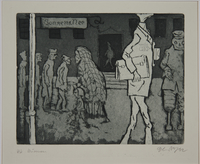
Plate 12, Herbert Sandberg, Der Weg: street scene with starving veterans and working class people
Object
Satiric aquatint, Die Dunnen, created by Herbert Sandberg depicting the poverty and starvation of the working class and war veterans, and the cruel and greedy moneyed classes that he observed in Berlin. It is one in the series, Der Weg [The Way], a limited edition of 70 intaglio prints created from 1958-1965 for Buchenwald Museum for the 20th anniversary of liberation. Sandberg was imprisoned for 11 years by the Nazi regime, 7 under brutal conditions in Buchenwald concentration camp. Der Weg is a comprehensive autobiographical cycle, made to remind people of the day to day life destroyed by the Nazi dictatorship, as well as the horrors and immorality of the camps. The main sections are: prints 1-25, pre-1933 life; 26-60, resistance and persecution, including reconstructions of drawings Sandberg made while incarcerated; and 61-70, survivors postwar and the making of a new Germany. Sandberg, 26, was arrested in Berlin in 1934 for distributing anti-Nazi literature. He was convicted of treason and jailed. In 1938, he was transferred to the recently opened Buchenwald, as prisoner 3491, marked as both a Jewish and a political prisoner. In 1944, ill and in the infirmary, Sandberg created his first artworks as a prisoner. Buchenwald was liberated on June 12, 1945, by US troops. Sandberg returned to Berlin and resumed his career.

Plate 13, Herbert Sandberg series, Der Weg: Mercury tossing money from a gun shell on fat businessmen
Object
Satiric aquatint created by Herbert Sandberg of the mythic god Mercury enriching fat, already wealthy, businessmen with the profits of war. It is one in the series, Der Weg [The Way], a limited edition of 70 intaglio prints created from 1958-1965 for Buchenwald Museum for the 20th anniversary of liberation. Sandberg was imprisoned for 11 years by the Nazi regime, 7 under brutal conditions in Buchenwald concentration camp. Der Weg is a comprehensive autobiographical cycle, made to remind people of the day to day life destroyed by the Nazi dictatorship, as well as the horrors and immorality of the camps. The main sections are: prints 1-25, pre-1933 experiences; 23-25, conversion to Communism; 26-60, resistance and persecution, including reconstructions of drawings Sandberg made while incarcerated; and 61-70, survivors postwar and the making of a new Germany. Sandberg, 26, was arrested in Berlin in 1934 for distributing anti-Nazi literature. He was convicted of treason and jailed. In 1938, he was transferred to the recently opened Buchenwald, as prisoner 3491, marked as both a Jewish and a political prisoner. In 1944, ill and in the infirmary, Sandberg created his first artworks as a prisoner. Buchenwald was liberated on June 12, 1945, by US troops. Sandberg returned to Berlin and resumed his career.
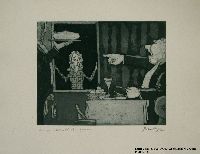
Plate 14, Herbert Sandberg series, Der Weg: a piglike man yells at a hungry girl for ruining his dinner
Object
Satiric aquatint, Hunger verdirbt den Appetit, created by Herbert Sandberg depicting a piglike, wealthy glutton berating a poor starving woman. It is one in the series, Der Weg [The Way], a limited edition of 70 intaglio prints created from 1958-1965 for Buchenwald Museum for the 20th anniversary of liberation. Sandberg was imprisoned for 11 years by the Nazi regime, 7 under brutal conditions in Buchenwald concentration camp. Der Weg is a comprehensive autobiographical cycle, made to remind people of the day to day life destroyed by the Nazi dictatorship, as well as the horrors and immorality of the camps. The main sections are: prints 1-25, pre-1933 life; 26-60, resistance and persecution, including reconstructions of drawings Sandberg made while incarcerated; and 61-70, survivors postwar and the making of a new Germany. Sandberg, 26, was arrested in Berlin in 1934 for distributing anti-Nazi literature. He was convicted of treason and jailed. In 1938, he was transferred to the recently opened Buchenwald, as prisoner 3491, marked as both a Jewish and a political prisoner. In 1944, ill and in the infirmary, Sandberg created his first artworks as a prisoner. Buchenwald was liberated on June 12, 1945, by US troops. Sandberg returned to Berlin and resumed his career.

Plate 15, Herbert Sandberg series, Der Weg: portrait of the artist when young sharing his bread with a starving man
Object
Aquatint, Geteilte Freude, created by Herbert Sandberg depicting his younger self sharing his bread with a starving man. It is one in the series, Der Weg (The Way), a limited edition of 70 intaglio prints created from 1958-1965 for Buchenwald Museum for the 20th anniversary of liberation. Sandberg was imprisoned for 11 years by the Nazi regime, 7 under brutal conditions in Buchenwald concentration camp. Der Weg is a comprehensive autobiographical cycle, made to remind people of the day to day life destroyed by the Nazi dictatorship, as well as the horrors and immorality of the camps. The main sections are: prints 1-25, pre-1933 life; 26-60, resistance and persecution, including reconstructions of drawings Sandberg made while incarcerated; and 61-70, survivors postwar and the making of a new Germany. Sandberg, 26, was arrested in Berlin in 1934 for distributing anti-Nazi literature. He was convicted of treason and jailed. In 1938, he was transferred to the recently opened Buchenwald, as prisoner 3491, marked as both a Jewish and a political prisoner. In 1944, ill and in the infirmary, Sandberg created his first artworks as a prisoner. Buchenwald was liberated on June 12, 1945, by US troops. Sandberg returned to Berlin and resumed his career.
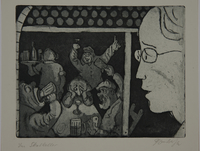
Plate 16, Herbert Sandberg series, Der Weg: young man looks with dismay at men drinking in a bar
Object
Aquatint, Im Skatcellar, created by Herbert Sandberg depicting his younger self looking with dismay at men drinking, yelling, and playing cards inside a pub. It is one in the series, Der Weg [The Way], a limited edition of 70 intaglio prints created from 1958-1965 for Buchenwald Museum for the 20th anniversary of liberation. Sandberg was imprisoned for 11 years by the Nazi regime, 7 under brutal conditions in Buchenwald concentration camp. Der Weg is a comprehensive autobiographical cycle, made to remind people of the day to day life destroyed by the Nazi dictatorship, as well as the horrors and immorality of the camps. The main sections are: prints 1-25, pre-1933 life; 26-60, resistance and persecution, including reconstructions of drawings Sandberg made while incarcerated; and 61-70, survivors postwar and the making of a new Germany. Sandberg, 26, was arrested in Berlin in 1934 for distributing anti-Nazi literature. He was convicted of treason and jailed. In 1938, he was transferred to the recently opened Buchenwald, as prisoner 3491, marked as both a Jewish and a political prisoner. In 1944, ill and in the infirmary, Sandberg created his first artworks as a prisoner. Buchenwald was liberated on June 12, 1945, by US troops. Sandberg returned to Berlin and resumed his career.
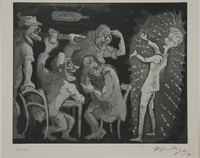
Plate 17, Herbert Sandberg series, Der Weg: young man makes a fool of himself in a bar
Object
Aquatint, Narren, created by Herbert Sandberg depicting his younger self, this time carousing in the bar with the working class men he looked down on in 1988.12.16. It is one in the series, Der Weg [The Way], a limited edition of 70 intaglio prints created from 1958-1965 for Buchenwald Museum for the 20th anniversary of liberation. Sandberg was imprisoned for 11 years by the Nazi regime, 7 under brutal conditions in Buchenwald concentration camp. Der Weg is a comprehensive autobiographical cycle, made to remind people of the day to day life destroyed by the Nazi dictatorship, as well as the horrors and immorality of the camps. The main sections are: prints 1-25, pre-1933 life; 26-60, resistance and persecution, including reconstructions of drawings Sandberg made while incarcerated; and 61-70, survivors postwar and the making of a new Germany. Sandberg, 26, was arrested in Berlin in 1934 for distributing anti-Nazi literature. He was convicted of treason and jailed. In 1938, he was transferred to the recently opened Buchenwald, as prisoner 3491, marked as both a Jewish and a political prisoner. In 1944, ill and in the infirmary, Sandberg created his first artworks as a prisoner. Buchenwald was liberated on June 12, 1945, by US troops. Sandberg returned to Berlin and resumed his career.
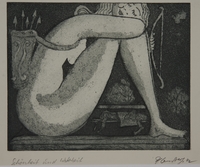
Plate 18, Herbert Sandberg series, Der Weg: sleeping nude goddess and a homeless man
Object
Aquatint, Schonheit and Wahrheit, created by Herbert Sandberg of a beautiful statuelike woman on a pedestal and a poor, starving man sleeping on a bench. It is one in the series, Der Weg [The Way], a limited edition of 70 intaglio prints created from 1958-1965 for Buchenwald Museum for the 20th anniversary of liberation. Sandberg was imprisoned for 11 years by the Nazi regime, 7 under brutal conditions in Buchenwald concentration camp. Der Weg is a comprehensive autobiographical cycle, made to remind people of the day to day life destroyed by the Nazi dictatorship, as well as the horrors and immorality of the camps. The main sections are: prints 1-25, pre-1933 life; 26-60, resistance and persecution, including reconstructions of drawings Sandberg made while incarcerated; and 61-70, survivors postwar and the making of a new Germany. Sandberg, 26, was arrested in Berlin in 1934 for distributing anti-Nazi literature. He was convicted of treason and jailed. In 1938, he was transferred to the recently opened Buchenwald, as prisoner 3491, marked as both a Jewish and a political prisoner. In 1944, ill and in the infirmary, Sandberg created his first artworks as a prisoner. Buchenwald was liberated on June 12, 1945, by US troops. Sandberg returned to Berlin and resumed his career.
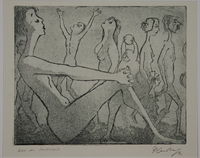
Plate 19, Herbert Sandberg series, Der Weg: a parade of nudes of different types
Object
Aquatint, Adel der Nacktheit, created by Herbert Sandberg depicting nude models, a memory of his life drawing classes as an art student. It is one in the series, Der Weg [The Way], a limited edition of 70 intaglio prints created from 1958-1965 for Buchenwald Museum for the 20th anniversary of liberation. Sandberg was imprisoned for 11 years by the Nazi regime, 7 under brutal conditions in Buchenwald concentration camp. Der Weg is a comprehensive autobiographical cycle, made to remind people of the day to day life destroyed by the Nazi dictatorship, as well as the horrors and immorality of the camps. The main sections are: prints 1-25, pre-1933 life; 26-60, resistance and persecution, including reconstructions of drawings Sandberg made while incarcerated; and 61-70, survivors postwar and the making of a new Germany. Sandberg, 26, was arrested in Berlin in 1934 for distributing anti-Nazi literature. He was convicted of treason and jailed. In 1938, he was transferred to the recently opened Buchenwald, as prisoner 3491, marked as both a Jewish and a political prisoner. In 1944, ill and in the infirmary, Sandberg created his first artworks as a prisoner. Buchenwald was liberated on June 12, 1945, by US troops. Sandberg returned to Berlin and resumed his career.
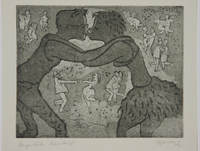
Plate 20, Herbert Sandberg series, Der Weg: young man and woman kissing
Object
Aquatint, Ungestorter Kreislauf, created by Herbert Sandberg of his younger self kissing a girl. It is one in the series, Der Weg (The Way), a limited edition of 70 intaglio prints created from 1958-1965 for Buchenwald Museum for the 20th anniversary of liberation. Sandberg was imprisoned for 11 years by the Nazi regime, 7 under brutal conditions in Buchenwald concentration camp. Der Weg is a comprehensive autobiographical cycle, made to remind people of the day to day life destroyed by the Nazi dictatorship, as well as the horrors and immorality of the camps. The main sections are: prints 1-25, pre-1933 life; 26-60, resistance and persecution, including reconstructions of drawings Sandberg made while incarcerated; and 61-70, survivors postwar and the making of a new Germany. Sandberg, 26, was arrested in Berlin in 1934 for distributing anti-Nazi literature. He was convicted of treason and jailed. In 1938, he was transferred to the recently opened Buchenwald, as prisoner 3491, marked as both a Jewish and a political prisoner. In 1944, ill and in the infirmary, Sandberg created his first artworks as a prisoner. Buchenwald was liberated on June 12, 1945, by US troops. Sandberg returned to Berlin and resumed his career.
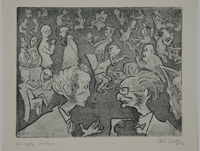
Plate 21, Herbert Sandberg series, Der Weg: cafe crowded with arguing artists
Object
Aquatint, Bewegte Geister, created by Herbert Sandberg of a cafe full of artistic types, most paired off and arguing. It is from the series, Der Weg [The Way], a limited edition of 70 intaglio prints created from 1958-1965 for Buchenwald Museum for the 20th anniversary of liberation. Sandberg was imprisoned for 11 years by the Nazi regime, 7 under brutal conditions in Buchenwald concentration camp. Der Weg is a comprehensive autobiographical cycle, made to remind people of the day to day life destroyed by the Nazi dictatorship, as well as the horrors and immorality of the camps. The main sections are: prints 1-25, pre-1933 life; 26-60, resistance and persecution, including reconstructions of drawings Sandberg made while incarcerated; and 61-70, survivors postwar and the making of a new Germany. Sandberg, 26, was arrested in Berlin in 1934 for distributing anti-Nazi literature. He was convicted of treason and jailed. In 1938, he was transferred to the recently opened Buchenwald, as prisoner 3491, marked as both a Jewish and a political prisoner. In 1944, ill and in the infirmary, Sandberg created his first artworks as a prisoner. Buchenwald was liberated on June 12, 1945, by US troops. Sandberg returned to Berlin and resumed his career.

Plate 22, Herbert Sandberg series, Der Weg: young man enjoying a humor magazine
Object
Aquatint, Vergnugte Leute, created by Herbert Sandberg of a young man laughing and reading Simplicissimus, a satirical German weekly magazine. It is from the series, Der Weg (The Way), a limited edition of 70 intaglio prints created from 1958-1965 for Buchenwald Museum for the 20th anniversary of liberation. Sandberg was imprisoned for 11 years by the Nazi regime, 7 under brutal conditions in Buchenwald concentration camp. Der Weg is a comprehensive autobiographical cycle, made to remind people of the day to day life destroyed by the Nazi dictatorship, as well as the horrors and immorality of the camps. The main sections are: prints 1-25, pre-1933 life; 26-60, resistance and persecution, including reconstructions of drawings Sandberg made while incarcerated; and 61-70, survivors postwar and the making of a new Germany. Sandberg, 26, was arrested in Berlin in 1934 for distributing anti-Nazi literature. He was convicted of treason and jailed. In 1938, he was transferred to the recently opened Buchenwald, as prisoner 3491, marked as both a Jewish and a political prisoner. In 1944, ill and in the infirmary, Sandberg created his first artworks as a prisoner. Buchenwald was liberated on June 12, 1945, by US troops. Sandberg returned to Berlin and resumed his career.
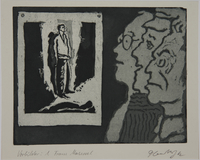
Plate 23, Herbert Sandberg series, Der Weg: artist as a young man with friends studying a woodcut
Object
Aquatint, Vorbiler: 1. Frans Masereel, created by Herbert Sandberg of people, including the artist's younger self, discussing a Masereel woodcut, an homage to Sandberg's favorite graphic artist. It is from the series, Der Weg (The Way), a limited edition of 70 intaglio prints created from 1958-1965 for Buchenwald Museum for the 20th anniversary of liberation. Sandberg was imprisoned for 11 years by the Nazi regime, 7 under brutal conditions in Buchenwald concentration camp. Der Weg is a comprehensive autobiographical cycle, made to remind people of the day to day life destroyed by the Nazi dictatorship, as well as the horrors and immorality of the camps. The main sections are: prints 1-25, pre-1933 life; 26-60, resistance and persecution, including reconstructions of drawings Sandberg made while incarcerated; and 61-70, survivors postwar and the making of a new Germany. Sandberg, 26, was arrested in Berlin in 1934 for distributing anti-Nazi literature. He was convicted of treason and jailed. In 1938, he was transferred to the recently opened Buchenwald, as prisoner 3491, marked as both a Jewish and a political prisoner. In 1944, ill and in the infirmary, Sandberg created his first artworks as a prisoner. Buchenwald was liberated on June 12, 1945, by US troops. Sandberg returned to Berlin and resumed his career.

Plate 24, Herbert Sandberg series, Der Weg: people watching an Eisenstein film
Object
Aquatint, Vorbilder II: Panzerkreuzer Potemkin, created by Herbert Sandberg of people watching the Odessa Steps sequence from the 1925 film, Battleship Potemkin, by Sergei Eisenstein. It is from the series, Der Weg [The Way], a limited edition of 70 intaglio prints created from 1958-1965 for Buchenwald Museum for the 20th anniversary of liberation. Sandberg was imprisoned for 11 years by the Nazi regime, 7 under brutal conditions in Buchenwald concentration camp. Der Weg is a comprehensive autobiographical cycle, made to remind people of the day to day life destroyed by the Nazi dictatorship, as well as the horrors and immorality of the camps. The main sections are: prints 1-25, pre-1933 life; 26-60, resistance and persecution, including reconstructions of drawings Sandberg made while incarcerated; and 61-70, survivors postwar and the making of a new Germany. Sandberg, 26, was arrested in Berlin in 1934 for distributing anti-Nazi literature. He was convicted of treason and jailed. In 1938, he was transferred to the recently opened Buchenwald, as prisoner 3491, marked as both a Jewish and a political prisoner. In 1944, ill and in the infirmary, Sandberg created his first artworks as a prisoner. Buchenwald was liberated on June 12, 1945, by US troops. Sandberg returned to Berlin and resumed his career.

Plate 25, Herbert Sandberg series, Der Weg: two men performing on separate stages
Object
Aquatint, Vorbilder 3: Ernst Busch und Erich Weinert, created by Herbert Sandberg showing two of his idols, the composer and singer Ernst Busch and the writer Erich Weinert. Both artists were Communists and political activists committed to social change for the working class, as was Sandberg. It is from the series, Der Weg [The Way], a limited edition of 70 intaglio prints created from 1958-1965 for Buchenwald Museum for the 20th anniversary of liberation. Sandberg was imprisoned for 11 years by the Nazi regime, 7 under brutal conditions in Buchenwald concentration camp. Der Weg is a comprehensive autobiographical cycle, made to remind people of the day to day life destroyed by the Nazi dictatorship, as well as the horrors and immorality of the camps. The main sections are: prints 1-25, pre-1933 life; 26-60, resistance and persecution, including reconstructions of drawings Sandberg made while incarcerated; and 61-70, survivors postwar and the making of a new Germany. Sandberg, 26, was arrested in Berlin in 1934 for distributing anti-Nazi literature. He was convicted of treason and jailed. In 1938, he was transferred to the recently opened Buchenwald, as prisoner 3491, marked as both a Jewish and a political prisoner. In 1944, ill and in the infirmary, Sandberg created his first artworks as a prisoner. Buchenwald was liberated on June 12, 1945, by US troops. Sandberg returned to Berlin and resumed his career.
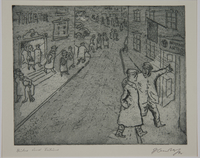
Plate 26, Herbert Sandberg series, Der Weg: people watching a film
Object
Aquatint, Buhne und Tribune, created by Herbert Sandberg showing people exiting a theater on one side of the street and entering an antifascist meeting on the other, the dual passions of his youth. It is from the series, Der Weg (The Way), a limited edition of 70 intaglio prints created from 1958-1965 for Buchenwald Museum for the 20th anniversary of liberation. Sandberg was imprisoned for 11 years by the Nazi regime, 7 under brutal conditions in Buchenwald concentration camp. Der Weg is a comprehensive autobiographical cycle, made to remind people of the day to day life destroyed by the Nazi dictatorship, as well as the horrors and immorality of the camps. The main sections are: prints 1-25, pre-1933 life; 26-60, resistance and persecution, including reconstructions of drawings Sandberg made while incarcerated; and 61-70, survivors postwar and the making of a new Germany. Sandberg, 26, was arrested in Berlin in 1934 for distributing anti-Nazi literature. He was convicted of treason and jailed. In 1938, he was transferred to the recently opened Buchenwald, as prisoner 3491, marked as both a Jewish and a political prisoner. In 1944, ill and in the infirmary, Sandberg created his first artworks as a prisoner. Buchenwald was liberated on June 12, 1945, by US troops. Sandberg returned to Berlin and resumed his career.
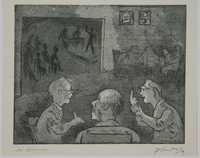
Plate 27, Herbert Sandberg series, Der Weg: men conversing in a social hall with a stage
Object
Aquatint, The Discussion, created by Herbert Sandberg showing people talking in a cafe or social hall with a stage performance in the background. It is from the series, Der Weg (The Way), a limited edition of 70 intaglio prints created from 1958-1965 for Buchenwald Museum for the 20th anniversary of liberation. Sandberg was imprisoned for 11 years by the Nazi regime, 7 under brutal conditions in Buchenwald concentration camp. Der Weg is a comprehensive autobiographical cycle, made to remind people of the day to day life destroyed by the Nazi dictatorship, as well as the horrors and immorality of the camps. The main sections are: prints 1-25, pre-1933 life; 26-60, resistance and persecution, including reconstructions of drawings Sandberg made while incarcerated; and 61-70, survivors postwar and the making of a new Germany. Sandberg, 26, was arrested in Berlin in 1934 for distributing anti-Nazi literature. He was convicted of treason and jailed. In 1938, he was transferred to the recently opened Buchenwald, as prisoner 3491, marked as both a Jewish and a political prisoner. In 1944, ill and in the infirmary, Sandberg created his first artworks as a prisoner. Buchenwald was liberated on June 12, 1945, by US troops. Sandberg returned to Berlin and resumed his career.
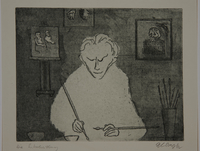
Plate 28, Herbert Sandberg series, Der Weg: a young painter at work
Object
Aquatint, The Decision, created by Herbert Sandberg of a young male painter at work. It is from the series, Der Weg (The Way), a limited edition of 70 intaglio prints created from 1958-1965 for Buchenwald Museum for the 20th anniversary of liberation. Sandberg was imprisoned for 11 years by the Nazi regime, 7 under brutal conditions in Buchenwald concentration camp. Der Weg is a comprehensive autobiographical cycle, made to remind people of the day to day life destroyed by the Nazi dictatorship, as well as the horrors and immorality of the camps. The main sections are: prints 1-25, pre-1933 life; 26-60, resistance and persecution, including reconstructions of drawings Sandberg made while incarcerated; and 61-70, survivors postwar and the making of a new Germany. Sandberg, 26, was arrested in Berlin in 1934 for distributing anti-Nazi literature. He was convicted of treason and jailed. In 1938, he was transferred to the recently opened Buchenwald, as prisoner 3491, marked as both a Jewish and a political prisoner. In 1944, ill and in the infirmary, Sandberg created his first artworks as a prisoner. Buchenwald was liberated on June 12, 1945, by US troops. Sandberg returned to Berlin and resumed his career.
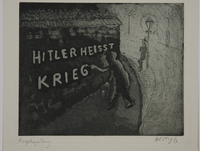
Plate 29, Herbert Sandberg series, Der Weg: a man painting Anti-Nazi graffitti
Object
Aquatint, The Prophecy, created by Herbert Sandberg of a man painting Hitler Heisst Krieg [Hitler Means War] on a wall. It is from the series, Der Weg (The Way), a limited edition of 70 intaglio prints created from 1958-1965 for Buchenwald Museum for the 20th anniversary of liberation. Sandberg was imprisoned for 11 years by the Nazi regime, 7 under brutal conditions in Buchenwald concentration camp. Der Weg is a comprehensive autobiographical cycle, made to remind people of the day to day life destroyed by the Nazi dictatorship, as well as the horrors and immorality of the camps. The main sections are: prints 1-25, pre-1933 life; 26-60, resistance and persecution, including reconstructions of drawings Sandberg made while incarcerated; and 61-70, survivors postwar and the making of a new Germany. Sandberg, 26, was arrested in Berlin in 1934 for distributing anti-Nazi literature. He was convicted of treason and jailed. In 1938, he was transferred to the recently opened Buchenwald, as prisoner 3491, marked as both a Jewish and a political prisoner. In 1944, ill and in the infirmary, Sandberg created his first artworks as a prisoner. Buchenwald was liberated on June 12, 1945, by US troops. Sandberg returned to Berlin and resumed his career.

Plate 30, Herbert Sandberg series, Der Weg: man with a Red Aid jar at a factory strike
Object
Aquatint, Solidarity, created by Herbert Sandberg of men on strike with a nearby figure resembling the artist holding a donation jar for Rote Hilfe [Red Aid], a German Communist aid group affiliated with the International Red Cross. It is from the series, Der Weg (The Way), a limited edition of 70 intaglio prints created from 1958-1965 for Buchenwald Museum for the 20th anniversary of liberation. Sandberg was imprisoned for 11 years by the Nazi regime, 7 under brutal conditions in Buchenwald concentration camp. Der Weg is a comprehensive autobiographical cycle, made to remind people of the day to day life destroyed by the Nazi dictatorship, as well as the horrors and immorality of the camps. The main sections are: prints 1-25, pre-1933 life; 26-60, resistance and persecution, including reconstructions of drawings Sandberg made while incarcerated; and 61-70, survivors postwar and the making of a new Germany. Sandberg, 26, was arrested in Berlin in 1934 for distributing anti-Nazi literature. He was convicted of treason and jailed. In 1938, he was transferred to the recently opened Buchenwald, as prisoner 3491, marked as both a Jewish and a political prisoner. In 1944, ill and in the infirmary, Sandberg created his first artworks as a prisoner. Buchenwald was liberated on June 12, 1945, by US troops. Sandberg returned to Berlin and resumed his career.
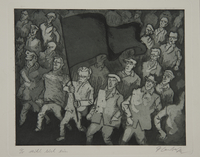
Plate 31, Herbert Sandberg series, Der Weg: a man painting Anti-Nazi graffitti
Object
Aquatint, He Joins the Lines, created by Herbert Sandberg of his younger self joining a line of working class Communist marchers protesting for social change. It is from the series, Der Weg (The Way), a limited edition of 70 intaglio prints created from 1958-1965 for Buchenwald Museum for the 20th anniversary of liberation. Sandberg was imprisoned for 11 years by the Nazi regime, 7 under brutal conditions in Buchenwald concentration camp. Der Weg is a comprehensive autobiographical cycle, made to remind people of the day to day life destroyed by the Nazi dictatorship, as well as the horrors and immorality of the camps. The main sections are: prints 1-25, pre-1933 life; 26-60, resistance and persecution, including reconstructions of drawings Sandberg made while incarcerated; and 61-70, survivors postwar and the making of a new Germany. Sandberg, 26, was arrested in Berlin in 1934 for distributing anti-Nazi literature. He was convicted of treason and jailed. In 1938, he was transferred to the recently opened Buchenwald, as prisoner 3491, marked as both a Jewish and a political prisoner. In 1944, ill and in the infirmary, Sandberg created his first artworks as a prisoner. Buchenwald was liberated on June 12, 1945, by US troops. Sandberg returned to Berlin and resumed his career.
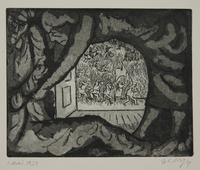
Plate 32, Herbert Sandberg series, Der Weg: Communist marchers attacked by police
Object
Aquatint, May 1, 1929, created by Herbert Sandberg depicting May Day or International Worker's Day's in Berlin in 1929. The Social Democratic government had prohibited outdoor demonstrations. The Communist Party refused to hold indoor meetings like the other trade unions and called for a boycott. As they marched in Berlin, they were clubbed and shot by German police; 27 were killed and hundreds injured. It is from the series, Der Weg (The Way), a limited edition of 70 intaglio prints created from 1958-1965 for Buchenwald Museum for the 20th anniversary of liberation. Sandberg was imprisoned for 11 years by the Nazi regime, 7 under brutal conditions in Buchenwald concentration camp. Der Weg is a comprehensive autobiographical cycle, made to remind people of the day to day life destroyed by the Nazi dictatorship, as well as the horrors and immorality of the camps. The main sections are: prints 1-25, pre-1933 life; 26-60, resistance and persecution, including reconstructions of drawings Sandberg made while incarcerated; and 61-70, survivors postwar and the making of a new Germany. Sandberg, 26, was arrested in Berlin in 1934 for distributing anti-Nazi literature. He was convicted of treason and jailed. In 1938, he was transferred to the recently opened Buchenwald, as prisoner 3491, marked as both a Jewish and a political prisoner. In 1944, ill and in the infirmary, Sandberg created his first artworks as a prisoner. Buchenwald was liberated on June 12, 1945, by US troops. Sandberg returned to Berlin and resumed his career.
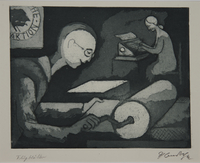
Plate 33, Herbert Sandberg series, Der Weg: young man printing political pamphlets
Object
Aquatint, Pamphlets, created by Herbert Sandberg depicting his younger self creating protest pamphlets for the Communist Party. It is from the series, Der Weg (The Way), a limited edition of 70 intaglio prints created from 1958-1965 for Buchenwald Museum for the 20th anniversary of liberation. Sandberg was imprisoned for 11 years by the Nazi regime, 7 under brutal conditions in Buchenwald concentration camp. Der Weg is a comprehensive autobiographical cycle, made to remind people of the day to day life destroyed by the Nazi dictatorship, as well as the horrors and immorality of the camps. The main sections are: prints 1-25, pre-1933 life; 26-60, resistance and persecution, including reconstructions of drawings Sandberg made while incarcerated; and 61-70, survivors postwar and the making of a new Germany. Sandberg, 26, was arrested in Berlin in 1934 for distributing anti-Nazi literature. He was convicted of treason and jailed. In 1938, he was transferred to the recently opened Buchenwald, as prisoner 3491, marked as both a Jewish and a political prisoner. In 1944, ill and in the infirmary, Sandberg created his first artworks as a prisoner. Buchenwald was liberated on June 12, 1945, by US troops. Sandberg returned to Berlin and resumed his career.

Plate 34, Herbert Sandberg series, Der Weg: scene ca. fall 1932 of the Nazis moving past political rivals
Object
Aquatint, The Breach, created by Herbert Sandberg showing Nazi Party thugs advancing into the spotlight between two other uniformed groups, the Anti-Fascist Action [Antifaschistische Aktion], a Communist paramilitary group formed in May 1932, and the Iron Front, [Eiserne Front], an anti-Nazi, anti-communist paramilitary group. Both groups were banned in 1933 wen the Nazi dictatorship was established. It is from the autobiographical series, Der Weg (The Way), a limited edition of 70 intaglio prints created from 1958-1965 for Buchenwald Museum for the 20th anniversary of liberation. Sandberg was imprisoned for 11 years by the Nazi regime, 7 under brutal conditions in Buchenwald concentration camp. Der Weg is a comprehensive autobiographical cycle, made to remind people of the day to day life destroyed by the Nazi dictatorship, as well as the horrors and immorality of the camps. The main sections are: prints 1-25, pre-1933 life; 26-60, resistance and persecution, including reconstructions of drawings Sandberg made while incarcerated; and 61-70, survivors postwar and the making of a new Germany. Sandberg, 26, was arrested in Berlin in 1934 for distributing anti-Nazi literature. He was convicted of treason and jailed. In 1938, he was transferred to the recently opened Buchenwald, as prisoner 3491, marked as both a Jewish and a political prisoner. In 1944, ill and in the infirmary, Sandberg created his first artworks as a prisoner. Buchenwald was liberated on June 12, 1945, by US troops. Sandberg returned to Berlin and resumed his career.

Plate 35, Herbert Sandberg series, Der Weg: a Nazi book burning
Object
Aquatint, First the Books, created by Herbert Sandberg depicting a Nazi regime book burning, ca. the April 6, 1933, nationwide "Action Against the Un-German Spirit." Sandberg has placed a see-through white heart over the books in the center of the bonfire. It is from the autobiographical series, Der Weg (The Way), a limited edition of 70 intaglio prints created from 1958-1965 for Buchenwald Museum for the 20th anniversary of liberation. Sandberg was imprisoned for 11 years by the Nazi regime, 7 under brutal conditions in Buchenwald concentration camp. Der Weg is a comprehensive autobiographical cycle, made to remind people of the day to day life destroyed by the Nazi dictatorship, as well as the horrors and immorality of the camps. The main sections are: prints 1-25, pre-1933 life; 26-60, resistance and persecution, including reconstructions of drawings Sandberg made while incarcerated; and 61-70, survivors postwar and the making of a new Germany. Sandberg, 26, was arrested in Berlin in 1934 for distributing anti-Nazi literature. He was convicted of treason and jailed. In 1938, he was transferred to the recently opened Buchenwald, as prisoner 3491, marked as both a Jewish and a political prisoner. In 1944, ill and in the infirmary, Sandberg created his first artworks as a prisoner. Buchenwald was liberated on June 12, 1945, by US troops. Sandberg returned to Berlin and resumed his career.
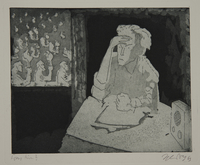
Plate 36, Herbert Sandberg series, Der Weg: man reacting angrily to a Nazi parade
Object
Aquatint, What to do, of a man angered by a parade of torch bearing Nazis created by Herbert Sandberg. It is from his autobiographical series, Der Weg (The Way), a limited edition of 70 intaglio prints created from 1958-1965 for Buchenwald Museum for the 20th anniversary of liberation. Sandberg was imprisoned for 11 years by the Nazi regime, 7 under brutal conditions in Buchenwald concentration camp. Der Weg is a comprehensive autobiographical cycle, made to remind people of the day to day life destroyed by the Nazi dictatorship, as well as the horrors and immorality of the camps. The main sections are: prints 1-25, pre-1933 life; 26-60, resistance and persecution, including reconstructions of drawings Sandberg made while incarcerated; and 61-70, survivors postwar and the making of a new Germany. Sandberg, 26, was arrested in Berlin in 1934 for distributing anti-Nazi literature. He was convicted of treason and jailed. In 1938, he was transferred to the recently opened Buchenwald, as prisoner 3491, marked as both a Jewish and a political prisoner. In 1944, ill and in the infirmary, Sandberg created his first artworks as a prisoner. Buchenwald was liberated on June 12, 1945, by US troops. Sandberg returned to Berlin and resumed his career.

Plate 37, Herbert Sandberg series, Der Weg: friends meeting in a social hall
Object
Aquatint, Continue, created by Herbert Sandberg of his younger self talking with two men in a social hall. It is from the autobiographical series, Der Weg (The Way), a limited edition of 70 intaglio prints created from 1958-1965 for Buchenwald Museum for the 20th anniversary of liberation. Sandberg was imprisoned for 11 years by the Nazi regime, 7 under brutal conditions in Buchenwald concentration camp. Der Weg is a comprehensive autobiographical cycle, made to remind people of the day to day life destroyed by the Nazi dictatorship, as well as the horrors and immorality of the camps. The main sections are: prints 1-25, pre-1933 life; 26-60, resistance and persecution, including reconstructions of drawings Sandberg made while incarcerated; and 61-70, survivors postwar and the making of a new Germany. Sandberg, 26, was arrested in Berlin in 1934 for distributing anti-Nazi literature. He was convicted of treason and jailed. In 1938, he was transferred to the recently opened Buchenwald, as prisoner 3491, marked as both a Jewish and a political prisoner. In 1944, ill and in the infirmary, Sandberg created his first artworks as a prisoner. Buchenwald was liberated on June 12, 1945, by US troops. Sandberg returned to Berlin and resumed his career.
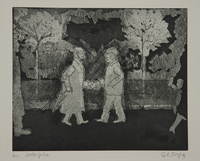
Plate 38, Herbert Sandberg series, Der Weg: 2 men exchanging a note in a park at night
Object
Aquatint, In Passing, created by Herbert Sandberg. It is from his autobiographical series, Der Weg (The Way), a limited edition of 70 intaglio prints created from 1958-1965 for Buchenwald Museum for the 20th anniversary of liberation. Sandberg was imprisoned for 11 years by the Nazi regime, 7 under brutal conditions in Buchenwald concentration camp. Der Weg is a comprehensive autobiographical cycle, made to remind people of the day to day life destroyed by the Nazi dictatorship, as well as the horrors and immorality of the camps. The main sections are: prints 1-25, pre-1933 life; 26-60, resistance and persecution, including reconstructions of drawings Sandberg made while incarcerated; and 61-70, survivors postwar and the making of a new Germany. Sandberg, 26, was arrested in Berlin in 1934 for distributing anti-Nazi literature. He was convicted of treason and jailed. In 1938, he was transferred to the recently opened Buchenwald, as prisoner 3491, marked as both a Jewish and a political prisoner. In 1944, ill and in the infirmary, Sandberg created his first artworks as a prisoner. Buchenwald was liberated on June 12, 1945, by US troops. Sandberg returned to Berlin and resumed his career.
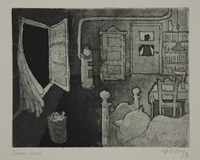
Plate 39, Herbert Sandberg series, Der Weg: an empty room with an open window, police at the door
Object
Aquatint, Empty Nest, created by Herbert Sandberg. It is from his autobiographical series, Der Weg (The Way), a limited edition of 70 intaglio prints created from 1958-1965 for Buchenwald Museum for the 20th anniversary of liberation. Sandberg was imprisoned for 11 years by the Nazi regime, 7 under brutal conditions in Buchenwald concentration camp. Der Weg is a comprehensive autobiographical cycle, made to remind people of the day to day life destroyed by the Nazi dictatorship, as well as the horrors and immorality of the camps. The main sections are: prints 1-25, pre-1933 life; 26-60, resistance and persecution, including reconstructions of drawings Sandberg made while incarcerated; and 61-70, survivors postwar and the making of a new Germany. Sandberg, 26, was arrested in Berlin in 1934 for distributing anti-Nazi literature. He was convicted of treason and jailed. In 1938, he was transferred to the recently opened Buchenwald, as prisoner 3491, marked as both a Jewish and a political prisoner. In 1944, ill and in the infirmary, Sandberg created his first artworks as a prisoner. Buchenwald was liberated on June 12, 1945, by US troops. Sandberg returned to Berlin and resumed his career.

Plate 40, Herbert Sandberg series, Der Weg: a young man being interrogated by Nazi Stormtroopers
Object
Aquatint, The Exam, created by Herbert Sandberg. It is from his autobiographical series, Der Weg (The Way), a limited edition of 70 intaglio prints created from 1958-1965 for Buchenwald Museum for the 20th anniversary of liberation. Sandberg was imprisoned for 11 years by the Nazi regime, 7 under brutal conditions in Buchenwald concentration camp. Der Weg is a comprehensive autobiographical cycle, made to remind people of the day to day life destroyed by the Nazi dictatorship, as well as the horrors and immorality of the camps. The main sections are: prints 1-25, pre-1933 life; 26-60, resistance and persecution, including reconstructions of drawings Sandberg made while incarcerated; and 61-70, survivors postwar and the making of a new Germany. Sandberg, 26, was arrested in Berlin in 1934 for distributing anti-Nazi literature. He was convicted of treason and jailed. In 1938, he was transferred to the recently opened Buchenwald, as prisoner 3491, marked as both a Jewish and a political prisoner. In 1944, ill and in the infirmary, Sandberg created his first artworks as a prisoner. Buchenwald was liberated on June 12, 1945, by US troops. Sandberg returned to Berlin and resumed his career.
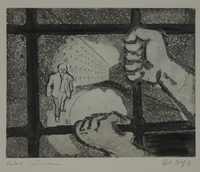
Plate 41, Herbert Sandberg series, Der Weg: view of a man through prison bars
Object
Aquatint, Save Thalmann!, created by Herbert Sandberg. Ernst Thalmann was the head of the Communist Party in Germany. After Hitler came to power in 1933, Thalmann was arrested, jailed in solitary confinement, and finally shot in Buchenwald in 1944. The print is from his autobiographical series, Der Weg (The Way), a limited edition of 70 intaglio prints created from 1958-1965 for Buchenwald Museum for the 20th anniversary of liberation. Sandberg was imprisoned for 11 years by the Nazi regime, 7 under brutal conditions in Buchenwald concentration camp. Der Weg is a comprehensive autobiographical cycle, made to remind people of the day to day life destroyed by the Nazi dictatorship, as well as the horrors and immorality of the camps. The main sections are: prints 1-25, pre-1933 life; 26-60, resistance and persecution, including reconstructions of drawings Sandberg made while incarcerated; and 61-70, survivors postwar and the making of a new Germany. Sandberg, 26, was arrested in Berlin in 1934 for distributing anti-Nazi literature. He was convicted of treason and jailed. In 1938, he was transferred to the recently opened Buchenwald, as prisoner 3491, marked as both a Jewish and a political prisoner. In 1944, ill and in the infirmary, Sandberg created his first artworks as a prisoner. Buchenwald was liberated on June 12, 1945, by US troops. Sandberg returned to Berlin and resumed his career.
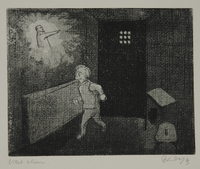
Plate 42, Herbert Sandberg series, Der Weg: prisoner with a vision of Lenin
Object
Aquatint, Not Alone, created by Herbert Sandberg depicting a young man in a jail cell glaring with anger at an illuminated image of Lenin. It is from his autobiographical series, Der Weg (The Way), a limited edition of 70 intaglio prints created from 1958-1965 for Buchenwald Museum for the 20th anniversary of liberation. Sandberg was imprisoned for 11 years by the Nazi regime, 7 under brutal conditions in Buchenwald concentration camp. Der Weg is a comprehensive autobiographical cycle, made to remind people of the day to day life destroyed by the Nazi dictatorship, as well as the horrors and immorality of the camps. The main sections are: prints 1-25, pre-1933 life; 26-60, resistance and persecution, including reconstructions of drawings Sandberg made while incarcerated; and 61-70, survivors postwar and the making of a new Germany. Sandberg, 26, was arrested in Berlin in 1934 for distributing anti-Nazi literature. He was convicted of treason and jailed. In 1938, he was transferred to the recently opened Buchenwald, as prisoner 3491, marked as both a Jewish and a political prisoner. In 1944, ill and in the infirmary, Sandberg created his first artworks as a prisoner. Buchenwald was liberated on June 12, 1945, by US troops. Sandberg returned to Berlin and resumed his career.

Plate 43, Herbert Sandberg series, Der Weg: men being brutally force marched by guards
Object
Aquatint, The Transport, created by Herbert Sandberg. It depcits uniformed guards force marching and beating a group of men in civilian clothes. It is from his autobiographical series, Der Weg (The Way), a limited edition of 70 intaglio prints created from 1958-1965 for Buchenwald Museum for the 20th anniversary of liberation. Sandberg was imprisoned for 11 years by the Nazi regime, 7 under brutal conditions in Buchenwald concentration camp. Der Weg is a comprehensive autobiographical cycle, made to remind people of the day to day life destroyed by the Nazi dictatorship, as well as the horrors and immorality of the camps. The main sections are: prints 1-25, pre-1933 life; 26-60, resistance and persecution, including reconstructions of drawings Sandberg made while incarcerated; and 61-70, survivors postwar and the making of a new Germany. Sandberg, 26, was arrested in Berlin in 1934 for distributing anti-Nazi literature. He was convicted of treason and jailed. In 1938, he was transferred to the recently opened Buchenwald, as prisoner 3491, marked as both a Jewish and a political prisoner. In 1944, ill and in the infirmary, Sandberg created his first artworks as a prisoner. Buchenwald was liberated on June 12, 1945, by US troops. Sandberg returned to Berlin and resumed his career.

Plate 44, Herbert Sandberg series, Der Weg: closeup of a guard yelling at a new prisoner
Object
Aquatint, Camp Entrance, created by Herbert Sandberg. It is from his autobiographical series, Der Weg (The Way), a limited edition of 70 intaglio prints created from 1958-1965 for Buchenwald Museum for the 20th anniversary of liberation. Sandberg was imprisoned for 11 years by the Nazi regime, 7 under brutal conditions in Buchenwald concentration camp. Der Weg is a comprehensive autobiographical cycle, made to remind people of the day to day life destroyed by the Nazi dictatorship, as well as the horrors and immorality of the camps. The main sections are: prints 1-25, pre-1933 life; 26-60, resistance and persecution, including reconstructions of drawings Sandberg made while incarcerated; and 61-70, survivors postwar and the making of a new Germany. Sandberg, 26, was arrested in Berlin in 1934 for distributing anti-Nazi literature. He was convicted of treason and jailed. In 1938, he was transferred to the recently opened Buchenwald, as prisoner 3491, marked as both a Jewish and a political prisoner. In 1944, ill and in the infirmary, Sandberg created his first artworks as a prisoner. Buchenwald was liberated on June 12, 1945, by US troops. Sandberg returned to Berlin and resumed his career.

Plate 45, Herbert Sandberg series, Der Weg: uniformed inmates carrying rocks
Object
Aquatint, Stone Age, created by Herbert Sandberg. It is from his autobiographical series, Der Weg (The Way), a limited edition of 70 intaglio prints created from 1958-1965 for Buchenwald Museum for the 20th anniversary of liberation. Sandberg was imprisoned for 11 years by the Nazi regime, 7 under brutal conditions in Buchenwald concentration camp. Der Weg is a comprehensive autobiographical cycle, made to remind people of the day to day life destroyed by the Nazi dictatorship, as well as the horrors and immorality of the camps. The main sections are: prints 1-25, pre-1933 life; 26-60, resistance and persecution, including reconstructions of drawings Sandberg made while incarcerated; and 61-70, survivors postwar and the making of a new Germany. Sandberg, 26, was arrested in Berlin in 1934 for distributing anti-Nazi literature. He was convicted of treason and jailed. In 1938, he was transferred to the recently opened Buchenwald, as prisoner 3491, marked as both a Jewish and a political prisoner. In 1944, ill and in the infirmary, Sandberg created his first artworks as a prisoner. Buchenwald was liberated on June 12, 1945, by US troops. Sandberg returned to Berlin and resumed his career.

Plate 46, Herbert Sandberg series, Der Weg: uniformed prison inmates pull a wagonload of rocks
Object
Aquatint, The Singing Horses, created by Herbert Sandberg. It is from his autobiographical series, Der Weg (The Way), a limited edition of 70 intaglio prints created from 1958-1965 for Buchenwald Museum for the 20th anniversary of liberation. Sandberg was imprisoned for 11 years by the Nazi regime, 7 under brutal conditions in Buchenwald concentration camp. Der Weg is a comprehensive autobiographical cycle, made to remind people of the day to day life destroyed by the Nazi dictatorship, as well as the horrors and immorality of the camps. The main sections are: prints 1-25, pre-1933 life; 26-60, resistance and persecution, including reconstructions of drawings Sandberg made while incarcerated; and 61-70, survivors postwar and the making of a new Germany. Sandberg, 26, was arrested in Berlin in 1934 for distributing anti-Nazi literature. He was convicted of treason and jailed. In 1938, he was transferred to the recently opened Buchenwald, as prisoner 3491, marked as both a Jewish and a political prisoner. In 1944, ill and in the infirmary, Sandberg created his first artworks as a prisoner. Buchenwald was liberated on June 12, 1945, by US troops. Sandberg returned to Berlin and resumed his career.

Plate 47, Herbert Sandberg series, Der Weg: uniformed inmates carry a huge log
Object
Aquatint, In the Green Heart of Germany, created by Herbert Sandberg. It is from his autobiographical series, Der Weg (The Way), a limited edition of 70 intaglio prints created from 1958-1965 for Buchenwald Museum for the 20th anniversary of liberation. Sandberg was imprisoned for 11 years by the Nazi regime, 7 under brutal conditions in Buchenwald concentration camp. Der Weg is a comprehensive autobiographical cycle, made to remind people of the day to day life destroyed by the Nazi dictatorship, as well as the horrors and immorality of the camps. The main sections are: prints 1-25, pre-1933 life; 26-60, resistance and persecution, including reconstructions of drawings Sandberg made while incarcerated; and 61-70, survivors postwar and the making of a new Germany. Sandberg, 26, was arrested in Berlin in 1934 for distributing anti-Nazi literature. He was convicted of treason and jailed. In 1938, he was transferred to the recently opened Buchenwald, as prisoner 3491, marked as both a Jewish and a political prisoner. In 1944, ill and in the infirmary, Sandberg created his first artworks as a prisoner. Buchenwald was liberated on June 12, 1945, by US troops. Sandberg returned to Berlin and resumed his career.
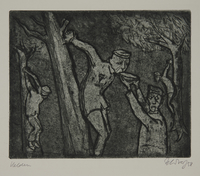
Plate 48, Herbert Sandberg series, Der Weg: inmates hung by their arms from trees
Object
Aquatint, Heroes, created by Herbert Sandberg. It is from his autobiographical series, Der Weg (The Way), a limited edition of 70 intaglio prints created from 1958-1965 for Buchenwald Museum for the 20th anniversary of liberation. Sandberg was imprisoned for 11 years by the Nazi regime, 7 under brutal conditions in Buchenwald concentration camp. Der Weg is a comprehensive autobiographical cycle, made to remind people of the day to day life destroyed by the Nazi dictatorship, as well as the horrors and immorality of the camps. The main sections are: prints 1-25, pre-1933 life; 26-60, resistance and persecution, including reconstructions of drawings Sandberg made while incarcerated; and 61-70, survivors postwar and the making of a new Germany. Sandberg, 26, was arrested in Berlin in 1934 for distributing anti-Nazi literature. He was convicted of treason and jailed. In 1938, he was transferred to the recently opened Buchenwald, as prisoner 3491, marked as both a Jewish and a political prisoner. In 1944, ill and in the infirmary, Sandberg created his first artworks as a prisoner. Buchenwald was liberated on June 12, 1945, by US troops. Sandberg returned to Berlin and resumed his career.
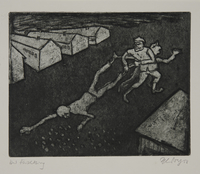
Plate 49, Herbert Sandberg series, Der Weg: two guards drag an emaciated prisoner
Object
Aquatint, The Fugitive, created by Herbert Sandberg. It is from his autobiographical series, Der Weg (The Way), a limited edition of 70 intaglio prints created from 1958-1965 for Buchenwald Museum for the 20th anniversary of liberation. Sandberg was imprisoned for 11 years by the Nazi regime, 7 under brutal conditions in Buchenwald concentration camp. Der Weg is a comprehensive autobiographical cycle, made to remind people of the day to day life destroyed by the Nazi dictatorship, as well as the horrors and immorality of the camps. The main sections are: prints 1-25, pre-1933 life; 26-60, resistance and persecution, including reconstructions of drawings Sandberg made while incarcerated; and 61-70, survivors postwar and the making of a new Germany. Sandberg, 26, was arrested in Berlin in 1934 for distributing anti-Nazi literature. He was convicted of treason and jailed. In 1938, he was transferred to the recently opened Buchenwald, as prisoner 3491, marked as both a Jewish and a political prisoner. In 1944, ill and in the infirmary, Sandberg created his first artworks as a prisoner. Buchenwald was liberated on June 12, 1945, by US troops. Sandberg returned to Berlin and resumed his career.
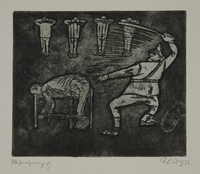
Plate 50, Herbert Sandberg series, Der Weg: guard beats a prisoner tied to a table
Object
Aquatint, Twenty-five, created by Herbert Sandberg. It is from his autobiographical series, Der Weg (The Way), a limited edition of 70 intaglio prints created from 1958-1965 for Buchenwald Museum for the 20th anniversary of liberation. Sandberg was imprisoned for 11 years by the Nazi regime, 7 under brutal conditions in Buchenwald concentration camp. Der Weg is a comprehensive autobiographical cycle, made to remind people of the day to day life destroyed by the Nazi dictatorship, as well as the horrors and immorality of the camps. The main sections are: prints 1-25, pre-1933 life; 26-60, resistance and persecution, including reconstructions of drawings Sandberg made while incarcerated; and 61-70, survivors postwar and the making of a new Germany. Sandberg, 26, was arrested in Berlin in 1934 for distributing anti-Nazi literature. He was convicted of treason and jailed. In 1938, he was transferred to the recently opened Buchenwald, as prisoner 3491, marked as both a Jewish and a political prisoner. In 1944, ill and in the infirmary, Sandberg created his first artworks as a prisoner. Buchenwald was liberated on June 12, 1945, by US troops. Sandberg returned to Berlin and resumed his career.
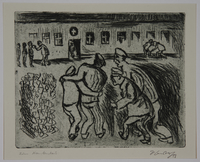
Plate 51, Herbert Sandberg series, Der Weg: infirm and elderly inmates walk to the hospital
Object
Aquatint, To the Hospital, created by Herbert Sandberg. It is from his autobiographical series, Der Weg (The Way), a limited edition of 70 intaglio prints created from 1958-1965 for Buchenwald Museum for the 20th anniversary of liberation. Sandberg was imprisoned for 11 years by the Nazi regime, 7 under brutal conditions in Buchenwald concentration camp. Der Weg is a comprehensive autobiographical cycle, made to remind people of the day to day life destroyed by the Nazi dictatorship, as well as the horrors and immorality of the camps. The main sections are: prints 1-25, pre-1933 life; 26-60, resistance and persecution, including reconstructions of drawings Sandberg made while incarcerated; and 61-70, survivors postwar and the making of a new Germany. Sandberg, 26, was arrested in Berlin in 1934 for distributing anti-Nazi literature. He was convicted of treason and jailed. In 1938, he was transferred to the recently opened Buchenwald, as prisoner 3491, marked as both a Jewish and a political prisoner. In 1944, ill and in the infirmary, Sandberg created his first artworks as a prisoner. Buchenwald was liberated on June 12, 1945, by US troops. Sandberg returned to Berlin and resumed his career.

Plate 52, Herbert Sandberg series, Der Weg: current inmates watch the new ones walk by
Object
Aquatint, POWs Arrive, created by Herbert Sandberg. It is from his autobiographical series, Der Weg (The Way), a limited edition of 70 intaglio prints created from 1958-1965 for Buchenwald Museum for the 20th anniversary of liberation. Sandberg was imprisoned for 11 years by the Nazi regime, 7 under brutal conditions in Buchenwald concentration camp. Der Weg is a comprehensive autobiographical cycle, made to remind people of the day to day life destroyed by the Nazi dictatorship, as well as the horrors and immorality of the camps. The main sections are: prints 1-25, pre-1933 life; 26-60, resistance and persecution, including reconstructions of drawings Sandberg made while incarcerated; and 61-70, survivors postwar and the making of a new Germany. Sandberg, 26, was arrested in Berlin in 1934 for distributing anti-Nazi literature. He was convicted of treason and jailed. In 1938, he was transferred to the recently opened Buchenwald, as prisoner 3491, marked as both a Jewish and a political prisoner. In 1944, ill and in the infirmary, Sandberg created his first artworks as a prisoner. Buchenwald was liberated on June 12, 1945, by US troops. Sandberg returned to Berlin and resumed his career.

Plate 54, Herbert Sandberg series, Der Weg: a prisoner catches bread tossed through his window
Object
Aquatint, Heads Up, created by Herbert Sandberg. It is from his autobiographical series, Der Weg (The Way), a limited edition of 70 intaglio prints created from 1958-1965 for Buchenwald Museum for the 20th anniversary of liberation. Sandberg was imprisoned for 11 years by the Nazi regime, 7 under brutal conditions in Buchenwald concentration camp. Der Weg is a comprehensive autobiographical cycle, made to remind people of the day to day life destroyed by the Nazi dictatorship, as well as the horrors and immorality of the camps. The main sections are: prints 1-25, pre-1933 life; 26-60, resistance and persecution, including reconstructions of drawings Sandberg made while incarcerated; and 61-70, survivors postwar and the making of a new Germany. Sandberg, 26, was arrested in Berlin in 1934 for distributing anti-Nazi literature. He was convicted of treason and jailed. In 1938, he was transferred to the recently opened Buchenwald, as prisoner 3491, marked as both a Jewish and a political prisoner. In 1944, ill and in the infirmary, Sandberg created his first artworks as a prisoner. Buchenwald was liberated on June 12, 1945, by US troops. Sandberg returned to Berlin and resumed his career.
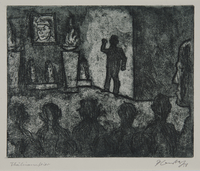
Plate 55, Herbert Sandberg series, Der Weg: memorial service for Ernst Thalmann (1886-1944)
Object
Aquatint, Thalmann celebration, created by Herbert Sandberg. Ernst Thalmann was the head of the Communist Party in Germany. After Hitler came to power in 1933, Thalmann was arrested, jailed in solitary confinement, and finally shot in Buchenwald on August 18, 1944. It is from his autobiographical series, Der Weg (The Way), a limited edition of 70 intaglio prints created from 1958-1965 for Buchenwald Museum for the 20th anniversary of liberation. Sandberg was imprisoned for 11 years by the Nazi regime, 7 under brutal conditions in Buchenwald concentration camp. Der Weg is a comprehensive autobiographical cycle, made to remind people of the day to day life destroyed by the Nazi dictatorship, as well as the horrors and immorality of the camps. The main sections are: prints 1-25, pre-1933 life; 26-60, resistance and persecution, including reconstructions of drawings Sandberg made while incarcerated; and 61-70, survivors postwar and the making of a new Germany. Sandberg, 26, was arrested in Berlin in 1934 for distributing anti-Nazi literature. He was convicted of treason and jailed. In 1938, he was transferred to the recently opened Buchenwald, as prisoner 3491, marked as both a Jewish and a political prisoner. In 1944, ill and in the infirmary, Sandberg created his first artworks as a prisoner. Buchenwald was liberated on June 12, 1945, by US troops. Sandberg returned to Berlin and resumed his career.

Plate 56, Herbert Sandberg series, Der Weg: prisoner with an illegal wireless radio
Object
Aquatint, Listening to Friends, created by Herbert Sandberg. It is from his autobiographical series, Der Weg (The Way), a limited edition of 70 intaglio prints created from 1958-1965 for Buchenwald Museum for the 20th anniversary of liberation. Sandberg was imprisoned for 11 years by the Nazi regime, 7 under brutal conditions in Buchenwald concentration camp. Der Weg is a comprehensive autobiographical cycle, made to remind people of the day to day life destroyed by the Nazi dictatorship, as well as the horrors and immorality of the camps. The main sections are: prints 1-25, pre-1933 life; 26-60, resistance and persecution, including reconstructions of drawings Sandberg made while incarcerated; and 61-70, survivors postwar and the making of a new Germany. Sandberg, 26, was arrested in Berlin in 1934 for distributing anti-Nazi literature. He was convicted of treason and jailed. In 1938, he was transferred to the recently opened Buchenwald, as prisoner 3491, marked as both a Jewish and a political prisoner. In 1944, ill and in the infirmary, Sandberg created his first artworks as a prisoner. Buchenwald was liberated on June 12, 1945, by US troops. Sandberg returned to Berlin and resumed his career.

Plate 57, Herbert Sandberg series, Der Weg: three prisoners deep in conversation
Object
Aquatint, Group of Three, created by Herbert Sandberg. It is from his autobiographical series, Der Weg (The Way), a limited edition of 70 intaglio prints created from 1958-1965 for Buchenwald Museum for the 20th anniversary of liberation. Sandberg was imprisoned for 11 years by the Nazi regime, 7 under brutal conditions in Buchenwald concentration camp. Der Weg is a comprehensive autobiographical cycle, made to remind people of the day to day life destroyed by the Nazi dictatorship, as well as the horrors and immorality of the camps. The main sections are: prints 1-25, pre-1933 life; 26-60, resistance and persecution, including reconstructions of drawings Sandberg made while incarcerated; and 61-70, survivors postwar and the making of a new Germany. Sandberg, 26, was arrested in Berlin in 1934 for distributing anti-Nazi literature. He was convicted of treason and jailed. In 1938, he was transferred to the recently opened Buchenwald, as prisoner 3491, marked as both a Jewish and a political prisoner. In 1944, ill and in the infirmary, Sandberg created his first artworks as a prisoner. Buchenwald was liberated on June 12, 1945, by US troops. Sandberg returned to Berlin and resumed his career.
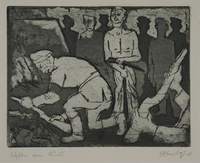
Plate 58, Herbert Sandberg series, Der Weg: men find rifles in the rubble
Object
Aquatint, Weapons of Light, created by Herbert Sandberg. It is from his autobiographical series, Der Weg (The Way), a limited edition of 70 intaglio prints created from 1958-1965 for Buchenwald Museum for the 20th anniversary of liberation. Sandberg was imprisoned for 11 years by the Nazi regime, 7 under brutal conditions in Buchenwald concentration camp. Der Weg is a comprehensive autobiographical cycle, made to remind people of the day to day life destroyed by the Nazi dictatorship, as well as the horrors and immorality of the camps. The main sections are: prints 1-25, pre-1933 life; 26-60, resistance and persecution, including reconstructions of drawings Sandberg made while incarcerated; and 61-70, survivors postwar and the making of a new Germany. Sandberg, 26, was arrested in Berlin in 1934 for distributing anti-Nazi literature. He was convicted of treason and jailed. In 1938, he was transferred to the recently opened Buchenwald, as prisoner 3491, marked as both a Jewish and a political prisoner. In 1944, ill and in the infirmary, Sandberg created his first artworks as a prisoner. Buchenwald was liberated on June 12, 1945, by US troops. Sandberg returned to Berlin and resumed his career.

Plate 59, Herbert Sandberg series, Der Weg: resistance fighter takes aim
Object
Aquatint, Freedom Alley, created by Herbert Sandberg. It is from his autobiographical series, Der Weg (The Way), a limited edition of 70 intaglio prints created from 1958-1965 for Buchenwald Museum for the 20th anniversary of liberation. Sandberg was imprisoned for 11 years by the Nazi regime, 7 under brutal conditions in Buchenwald concentration camp. Der Weg is a comprehensive autobiographical cycle, made to remind people of the day to day life destroyed by the Nazi dictatorship, as well as the horrors and immorality of the camps. The main sections are: prints 1-25, pre-1933 life; 26-60, resistance and persecution, including reconstructions of drawings Sandberg made while incarcerated; and 61-70, survivors postwar and the making of a new Germany. Sandberg, 26, was arrested in Berlin in 1934 for distributing anti-Nazi literature. He was convicted of treason and jailed. In 1938, he was transferred to the recently opened Buchenwald, as prisoner 3491, marked as both a Jewish and a political prisoner. In 1944, ill and in the infirmary, Sandberg created his first artworks as a prisoner. Buchenwald was liberated on June 12, 1945, by US troops. Sandberg returned to Berlin and resumed his career.
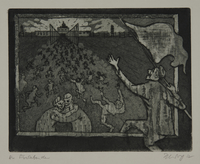
Plate 60, Herbert Sandberg series, Der Weg: prisoners rejoice in their freedom
Object
Aquatint, The Survivors, created by Herbert Sandberg. It is from his autobiographical series, Der Weg (The Way), a limited edition of 70 intaglio prints created from 1958-1965 for Buchenwald Museum for the 20th anniversary of liberation. Sandberg was imprisoned for 11 years by the Nazi regime, 7 under brutal conditions in Buchenwald concentration camp. Der Weg is a comprehensive autobiographical cycle, made to remind people of the day to day life destroyed by the Nazi dictatorship, as well as the horrors and immorality of the camps. The main sections are: prints 1-25, pre-1933 life; 26-60, resistance and persecution, including reconstructions of drawings Sandberg made while incarcerated; and 61-70, survivors postwar and the making of a new Germany. Sandberg, 26, was arrested in Berlin in 1934 for distributing anti-Nazi literature. He was convicted of treason and jailed. In 1938, he was transferred to the recently opened Buchenwald, as prisoner 3491, marked as both a Jewish and a political prisoner. In 1944, ill and in the infirmary, Sandberg created his first artworks as a prisoner. Buchenwald was liberated on June 12, 1945, by US troops. Sandberg returned to Berlin and resumed his career.

Plate 61, Herbert Sandberg series, Der Weg: local Germans made to view inmate corpses
Object
Aquatint, This we did not know, created by Herbert Sandberg, depicting himself in his camp uniform confronting local Germans forced to view a large pile of dead inmates. It is from his autobiographical series, Der Weg (The Way), a limited edition of 70 intaglio prints created from 1958-1965 for Buchenwald Museum for the 20th anniversary of liberation. Sandberg was imprisoned for 11 years by the Nazi regime, 7 under brutal conditions in Buchenwald concentration camp. Der Weg is a comprehensive autobiographical cycle, made to remind people of the day to day life destroyed by the Nazi dictatorship, as well as the horrors and immorality of the camps. The main sections are: prints 1-25, pre-1933 life; 26-60, resistance and persecution, including reconstructions of drawings Sandberg made while incarcerated; and 61-70, survivors postwar and the making of a new Germany. Sandberg, 26, was arrested in Berlin in 1934 for distributing anti-Nazi literature. He was convicted of treason and jailed. In 1938, he was transferred to the recently opened Buchenwald, as prisoner 3491, marked as both a Jewish and a political prisoner. In 1944, ill and in the infirmary, Sandberg created his first artworks as a prisoner. Buchenwald was liberated on June 12, 1945, by US troops. Sandberg returned to Berlin and resumed his career.
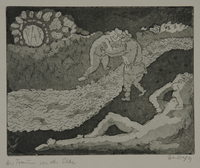
Plate 62, Herbert Sandberg series, Der Weg: man gazes in relief at Peace and the Elbe
Object
Aquatint, Dreams of the Elbe, created by Herbert Sandberg. It is from his autobiographical series, Der Weg (The Way), a limited edition of 70 intaglio prints created from 1958-1965 for Buchenwald Museum for the 20th anniversary of liberation. Sandberg was imprisoned for 11 years by the Nazi regime, 7 under brutal conditions in Buchenwald concentration camp. Der Weg is a comprehensive autobiographical cycle, made to remind people of the day to day life destroyed by the Nazi dictatorship, as well as the horrors and immorality of the camps. The main sections are: prints 1-25, pre-1933 life; 26-60, resistance and persecution, including reconstructions of drawings Sandberg made while incarcerated; and 61-70, survivors postwar and the making of a new Germany. Sandberg, 26, was arrested in Berlin in 1934 for distributing anti-Nazi literature. He was convicted of treason and jailed. In 1938, he was transferred to the recently opened Buchenwald, as prisoner 3491, marked as both a Jewish and a political prisoner. In 1944, ill and in the infirmary, Sandberg created his first artworks as a prisoner. Buchenwald was liberated on June 12, 1945, by US troops. Sandberg returned to Berlin and resumed his career.
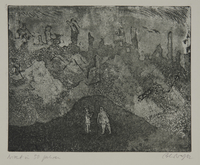
Plate 63, Herbert Sandberg series, Der Weg: two men converse among the ruins of a great city
Object
Aquatint, Not in 50 Years, created by Herbert Sandberg. It is from his autobiographical series, Der Weg (The Way), a limited edition of 70 intaglio prints created from 1958-1965 for Buchenwald Museum for the 20th anniversary of liberation. Sandberg was imprisoned for 11 years by the Nazi regime, 7 under brutal conditions in Buchenwald concentration camp. Der Weg is a comprehensive autobiographical cycle, made to remind people of the day to day life destroyed by the Nazi dictatorship, as well as the horrors and immorality of the camps. The main sections are: prints 1-25, pre-1933 life; 26-60, resistance and persecution, including reconstructions of drawings Sandberg made while incarcerated; and 61-70, survivors postwar and the making of a new Germany. Sandberg, 26, was arrested in Berlin in 1934 for distributing anti-Nazi literature. He was convicted of treason and jailed. In 1938, he was transferred to the recently opened Buchenwald, as prisoner 3491, marked as both a Jewish and a political prisoner. In 1944, ill and in the infirmary, Sandberg created his first artworks as a prisoner. Buchenwald was liberated on June 12, 1945, by US troops. Sandberg returned to Berlin and resumed his career.
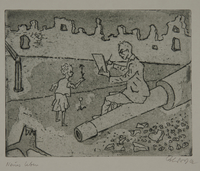
Plate 64, Herbert Sandberg series, Der Weg: girl offers a flower to a man sketching among the rubble
Object
Aquatint, New Life, created by Herbert Sandberg, depicting himself sketching in postwar Berlin.. It is from his autobiographical series, Der Weg (The Way), a limited edition of 70 intaglio prints created from 1958-1965 for Buchenwald Museum for the 20th anniversary of liberation. Sandberg was imprisoned for 11 years by the Nazi regime, 7 under brutal conditions in Buchenwald concentration camp. Der Weg is a comprehensive autobiographical cycle, made to remind people of the day to day life destroyed by the Nazi dictatorship, as well as the horrors and immorality of the camps. The main sections are: prints 1-25, pre-1933 life; 26-60, resistance and persecution, including reconstructions of drawings Sandberg made while incarcerated; and 61-70, survivors postwar and the making of a new Germany. Sandberg, 26, was arrested in Berlin in 1934 for distributing anti-Nazi literature. He was convicted of treason and jailed. In 1938, he was transferred to the recently opened Buchenwald, as prisoner 3491, marked as both a Jewish and a political prisoner. In 1944, ill and in the infirmary, Sandberg created his first artworks as a prisoner. Buchenwald was liberated on June 12, 1945, by US troops. Sandberg returned to Berlin and resumed his career.
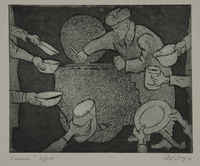
Plate 65, Herbert Sandberg series, Der Weg: communal soup pot amid empty dishes
Object
Aquatint, Sitschas! Now!, created by Herbert Sandberg. It is from his autobiographical series, Der Weg (The Way), a limited edition of 70 intaglio prints created from 1958-1965 for Buchenwald Museum for the 20th anniversary of liberation. Sandberg was imprisoned for 11 years by the Nazi regime, 7 under brutal conditions in Buchenwald concentration camp. Der Weg is a comprehensive autobiographical cycle, made to remind people of the day to day life destroyed by the Nazi dictatorship, as well as the horrors and immorality of the camps. The main sections are: prints 1-25, pre-1933 life; 26-60, resistance and persecution, including reconstructions of drawings Sandberg made while incarcerated; and 61-70, survivors postwar and the making of a new Germany. Sandberg, 26, was arrested in Berlin in 1934 for distributing anti-Nazi literature. He was convicted of treason and jailed. In 1938, he was transferred to the recently opened Buchenwald, as prisoner 3491, marked as both a Jewish and a political prisoner. In 1944, ill and in the infirmary, Sandberg created his first artworks as a prisoner. Buchenwald was liberated on June 12, 1945, by US troops. Sandberg returned to Berlin and resumed his career.

Plate 66, Herbert Sandberg series, Der Weg: men and women clearing rubble
Object
Aquatint, There were many bricks, created by Herbert Sandberg. It is from his autobiographical series, Der Weg (The Way), a limited edition of 70 intaglio prints created from 1958-1965 for Buchenwald Museum for the 20th anniversary of liberation. Sandberg was imprisoned for 11 years by the Nazi regime, 7 under brutal conditions in Buchenwald concentration camp. Der Weg is a comprehensive autobiographical cycle, made to remind people of the day to day life destroyed by the Nazi dictatorship, as well as the horrors and immorality of the camps. The main sections are: prints 1-25, pre-1933 life; 26-60, resistance and persecution, including reconstructions of drawings Sandberg made while incarcerated; and 61-70, survivors postwar and the making of a new Germany. Sandberg, 26, was arrested in Berlin in 1934 for distributing anti-Nazi literature. He was convicted of treason and jailed. In 1938, he was transferred to the recently opened Buchenwald, as prisoner 3491, marked as both a Jewish and a political prisoner. In 1944, ill and in the infirmary, Sandberg created his first artworks as a prisoner. Buchenwald was liberated on June 12, 1945, by US troops. Sandberg returned to Berlin and resumed his career.

Plate 67, Herbert Sandberg series, Der Weg: man offering handbills to a line of men and women
Object
Aquatint, Supply and Demand, created by Herbert Sandberg, depicting himself, back to community organizing, handing out leaflets in postwar Berlin. It is from his autobiographical series, Der Weg (The Way), a limited edition of 70 intaglio prints created from 1958-1965 for Buchenwald Museum for the 20th anniversary of liberation. Sandberg was imprisoned for 11 years by the Nazi regime, 7 under brutal conditions in Buchenwald concentration camp. Der Weg is a comprehensive autobiographical cycle, made to remind people of the day to day life destroyed by the Nazi dictatorship, as well as the horrors and immorality of the camps. The main sections are: prints 1-25, pre-1933 life; 26-60, resistance and persecution, including reconstructions of drawings Sandberg made while incarcerated; and 61-70, survivors postwar and the making of a new Germany. Sandberg, 26, was arrested in Berlin in 1934 for distributing anti-Nazi literature. He was convicted of treason and jailed. In 1938, he was transferred to the recently opened Buchenwald, as prisoner 3491, marked as both a Jewish and a political prisoner. In 1944, ill and in the infirmary, Sandberg created his first artworks as a prisoner. Buchenwald was liberated on June 12, 1945, by US troops. Sandberg returned to Berlin and resumed his career.
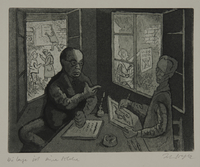
Plate 68, Herbert Sandberg series, Der Weg: the artist and editor in a magazine's office
Object
Aquatint, Current state of affairs, created by Herbert Sandberg. It is from his autobiographical series, Der Weg (The Way), a limited edition of 70 intaglio prints created from 1958-1965 for Buchenwald Museum for the 20th anniversary of liberation. Sandberg was imprisoned for 11 years by the Nazi regime, 7 under brutal conditions in Buchenwald concentration camp. Der Weg is a comprehensive autobiographical cycle, made to remind people of the day to day life destroyed by the Nazi dictatorship, as well as the horrors and immorality of the camps. The main sections are: prints 1-25, pre-1933 life; 26-60, resistance and persecution, including reconstructions of drawings Sandberg made while incarcerated; and 61-70, survivors postwar and the making of a new Germany. Sandberg, 26, was arrested in Berlin in 1934 for distributing anti-Nazi literature. He was convicted of treason and jailed. In 1938, he was transferred to the recently opened Buchenwald, as prisoner 3491, marked as both a Jewish and a political prisoner. In 1944, ill and in the infirmary, Sandberg created his first artworks as a prisoner. Buchenwald was liberated on June 12, 1945, by US troops. Sandberg returned to Berlin and resumed his career.
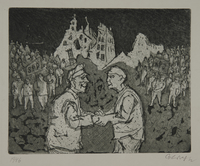
Plate 69, Herbert Sandberg series, Der Weg: 2 men agreeing to the merger of the KPD and SPD
Object
Aquatint, 1946, created by Herbert Sandberg, representing the merger of the KPD [Communist Party] and SPD [Social Democratic Party] into the Socialsit Unity Party of Germany. It is from his autobiographical series, Der Weg (The Way), a limited edition of 70 intaglio prints created from 1958-1965 for Buchenwald Museum for the 20th anniversary of liberation. Sandberg was imprisoned for 11 years by the Nazi regime, 7 under brutal conditions in Buchenwald concentration camp. Der Weg is a comprehensive autobiographical cycle, made to remind people of the day to day life destroyed by the Nazi dictatorship, as well as the horrors and immorality of the camps. The main sections are: prints 1-25, pre-1933 life; 26-60, resistance and persecution, including reconstructions of drawings Sandberg made while incarcerated; and 61-70, survivors postwar and the making of a new Germany. Sandberg, 26, was arrested in Berlin in 1934 for distributing anti-Nazi literature. He was convicted of treason and jailed. In 1938, he was transferred to the recently opened Buchenwald, as prisoner 3491, marked as both a Jewish and a political prisoner. In 1944, ill and in the infirmary, Sandberg created his first artworks as a prisoner. Buchenwald was liberated on June 12, 1945, by US troops. Sandberg returned to Berlin and resumed his career.

Plate 70, Herbert Sandberg series, Der Weg: four men walking to work
Object
Aquatint, And we must succeed, created by Herbert Sandberg. It is from his autobiographical series, Der Weg (The Way), a limited edition of 70 intaglio prints created from 1958-1965 for Buchenwald Museum for the 20th anniversary of liberation. Sandberg was imprisoned for 11 years by the Nazi regime, 7 under brutal conditions in Buchenwald concentration camp. Der Weg is a comprehensive autobiographical cycle, made to remind people of the day to day life destroyed by the Nazi dictatorship, as well as the horrors and immorality of the camps. The main sections are: prints 1-25, pre-1933 life; 26-60, resistance and persecution, including reconstructions of drawings Sandberg made while incarcerated; and 61-70, survivors postwar and the making of a new Germany. Sandberg, 26, was arrested in Berlin in 1934 for distributing anti-Nazi literature. He was convicted of treason and jailed. In 1938, he was transferred to the recently opened Buchenwald, as prisoner 3491, marked as both a Jewish and a political prisoner. In 1944, ill and in the infirmary, Sandberg created his first artworks as a prisoner. Buchenwald was liberated on June 12, 1945, by US troops. Sandberg returned to Berlin and resumed his career.

